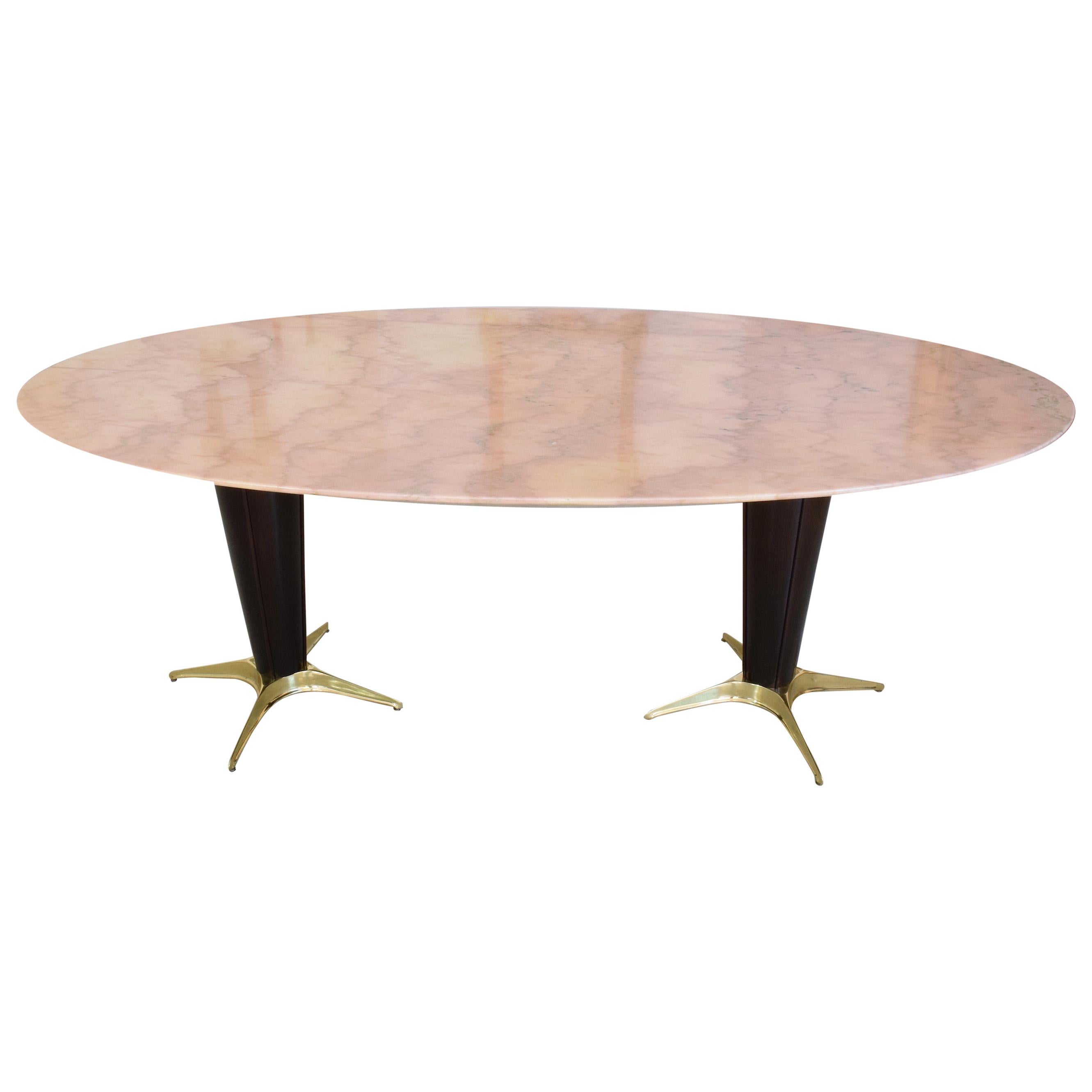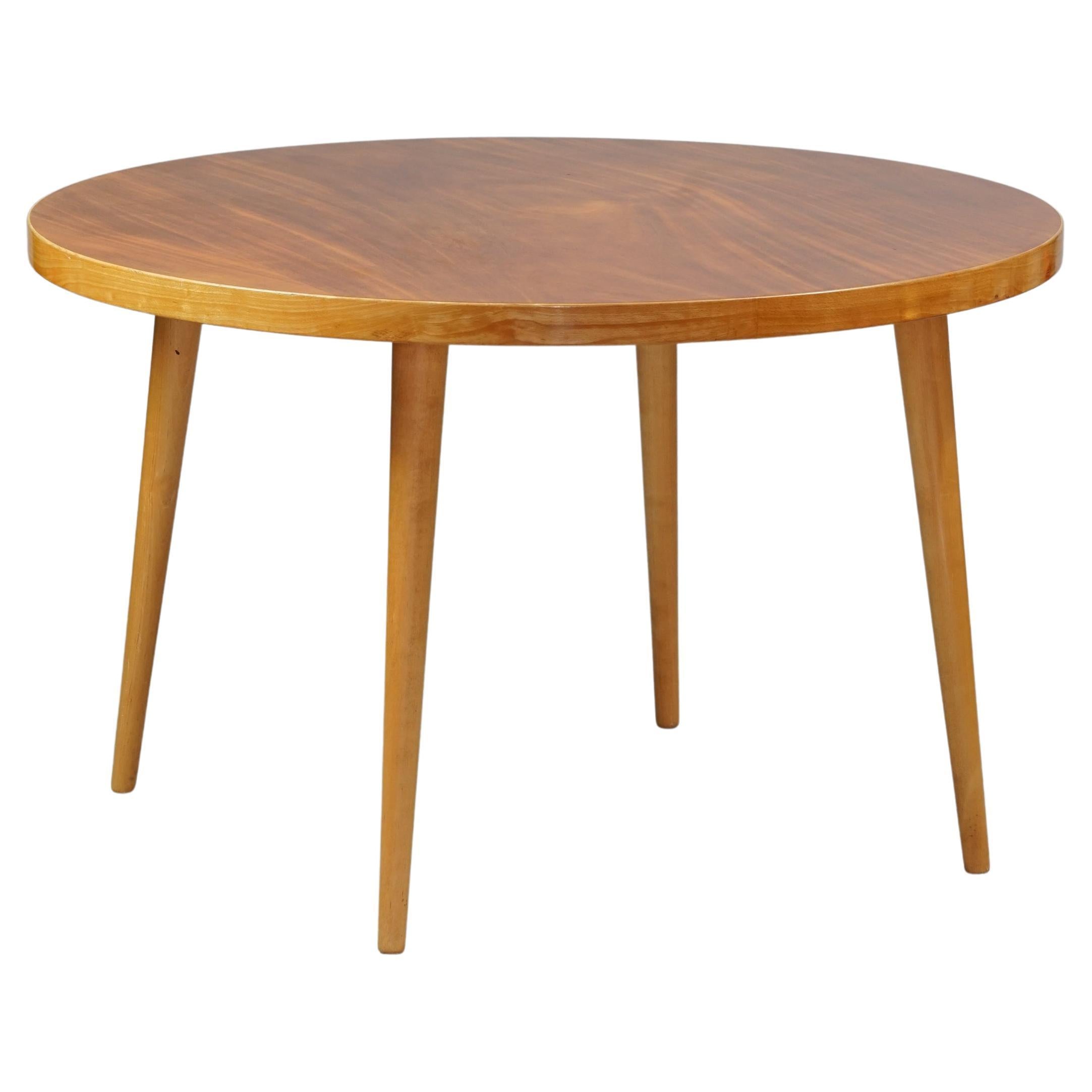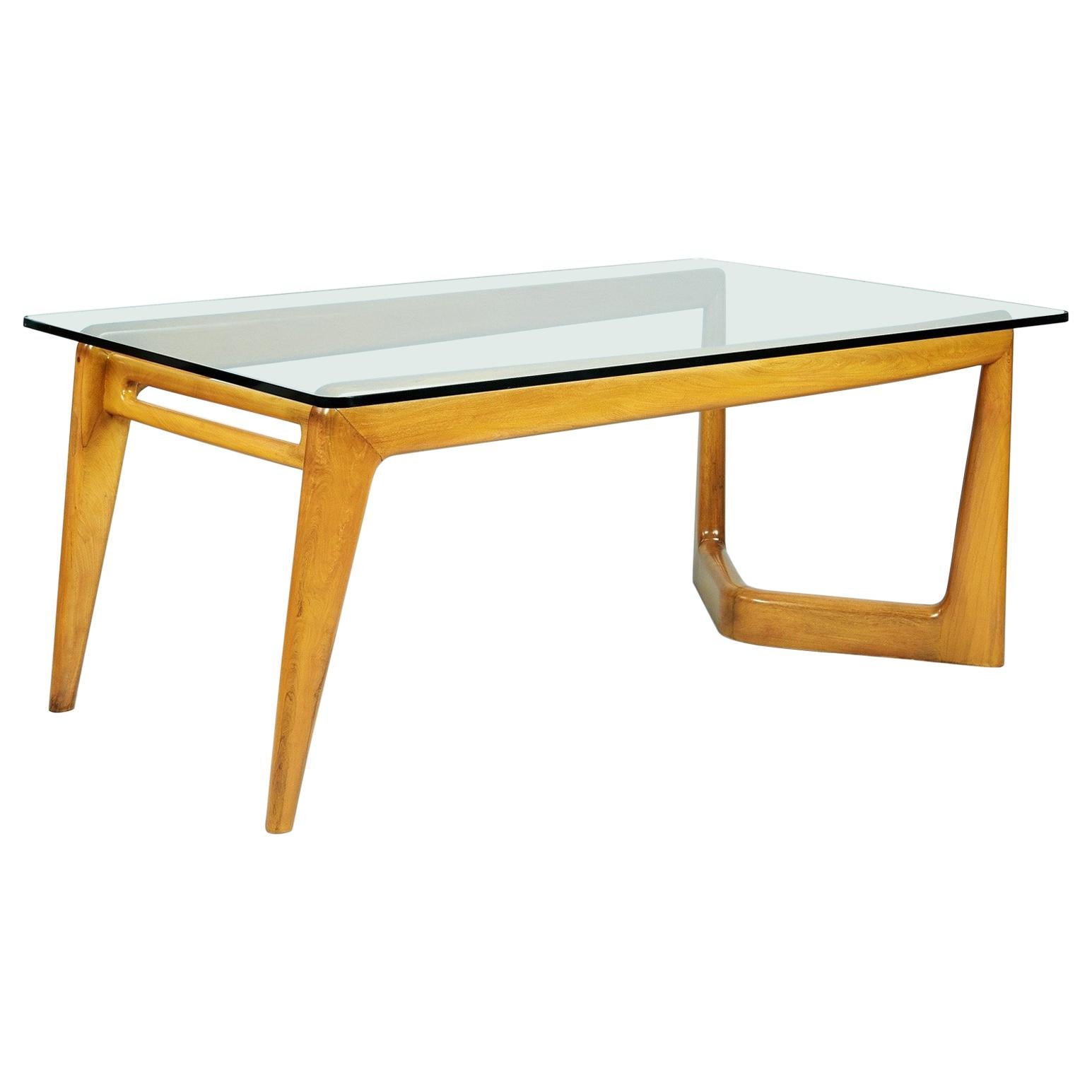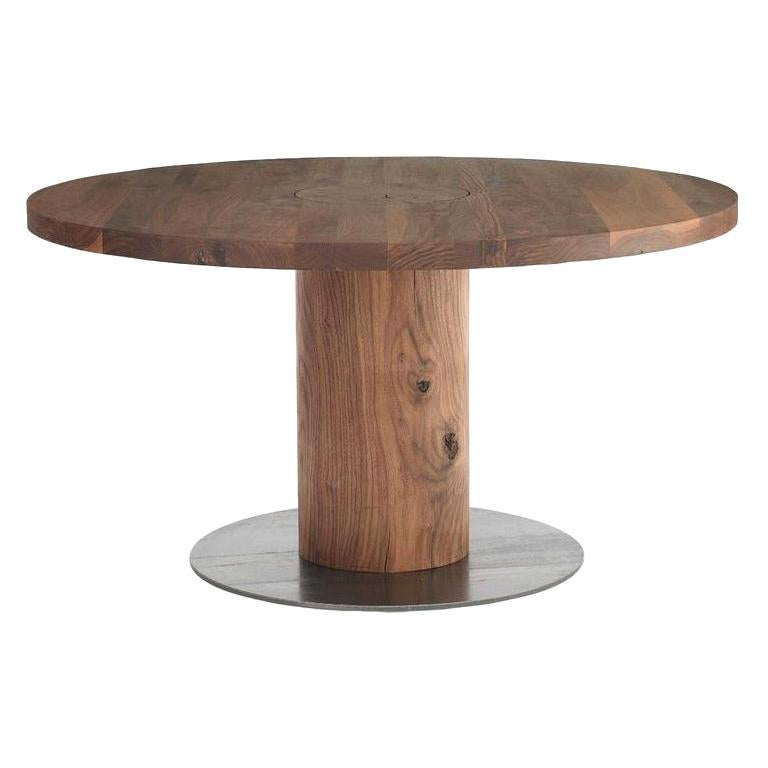Items Similar to Round Dining Table by Ariberto Colombo in Marble and Wood, Italy, 1950s
Want more images or videos?
Request additional images or videos from the seller
1 of 8
Round Dining Table by Ariberto Colombo in Marble and Wood, Italy, 1950s
About the Item
This round dining table has a remarkable wooden structure and a tabletop of white-grey marble from the Carrara region of Italy. It is very well preserved over the years and the color of the wood is very vibrantly brown and matured. The marble top is in perfect condition and has very pleasant tones of grey and is quite elegant compared to the more sturdy frame. This supporting wooden structure is curved on the inside, giving this stylish table a playful character too. The small ridges on the outside highlight the eye for detail in that period. The frame consists of four tapered boomerang-shaped legs, symmetrically connected by a circular framework. This table really has character and is great to observe, every time you pass it or sit at it....
- Creator:Ariberto Colombo (Designer)
- Dimensions:Height: 30.32 in (77 cm)Diameter: 47.25 in (120 cm)
- Materials and Techniques:Carrara Marble,Wood
- Place of Origin:Italy
- Period:1960-1969
- Date of Manufacture:1960
- Condition:
- Seller Location:Amsterdam, NL
- Reference Number:1stDibs: LU5211222275472
About the Seller
5.0
Vetted Seller
These experienced sellers undergo a comprehensive evaluation by our team of in-house experts.
Established in 2010
1stDibs seller since 2020
47 sales on 1stDibs
Typical response time: 1 hour
- ShippingRetrieving quote...Ships From: Amstelveen, Netherlands
- Return PolicyA return for this item may be initiated within 7 days of delivery.
More From This SellerView All
- Sculptural Dining Table by Ariberto Colombo in Teak, Brass and Glass, 1950'sLocated in Amsterdam, NLSculptural Italian dining table by Ariberto Colombo with a teak frame that has aged beautifully over time. The frame is held together b...Category
Vintage 1960s Italian Dining Room Tables
MaterialsBrass
- Sculptural Dining Table with Two Drop Leaves in Teak, Denmark, 1960'sLocated in Amsterdam, NLClever dining table with interesting base that folds out to let the drop-leaves rest on. Nice geometrical shapes and made with a lot of care and precision. Very practical design and ...Category
Vintage 1960s Danish Mid-Century Modern Dining Room Tables
MaterialsTeak
- Carlo Ratti Dining Table in Wood and Metal, Italy, 1960'sBy Carlo RattiLocated in Amsterdam, NLSmaller dining-room table with typical graceful Italian shapes. The table has somewhat flat and tapered legs and a V-shaped construction in metal and wood. Some nice details can be f...Category
Vintage 1960s Italian Mid-Century Modern Dining Room Tables
MaterialsMetal
- Carlo Ratti Dining Table in Wood and Metal, Italy, 1960'sBy Carlo RattiLocated in Amsterdam, NLElegant dining table with romantic steel base. The top has been lacquered and is quite shiny and in very good condition. The shape of the top is slightly tapered towards the sides. T...Category
Vintage 1960s Italian Mid-Century Modern Dining Room Tables
MaterialsMetal
- Dining Table AT 312 by Hans Wegner for Andreas Tuck in Oak, Denmark, 1960'sBy Hans J. Wegner, Andreas TuckLocated in Amsterdam, NLDining table model AT-312 designed by Hans Wegner for Andreas Tuck, Denmark, 1960s. Made in oak, the table boasts two pull-out leaves which hide under th...Category
Vintage 1960s Danish Mid-Century Modern Dining Room Tables
MaterialsOak
- Ico Parisi ‘Tivoli’ Coffee Table in Teak for MIM Roma, Italy, 1958By Ico Parisi, MIM RomaLocated in Amsterdam, NLArchitectural coffee table by Ico Parisi for MIM Roma called the 'Tivoli Coffee Table". The table is in a very good condition, no disturbing traces...Category
Vintage 1950s Italian Coffee and Cocktail Tables
MaterialsMetal
You May Also Like
- Italian Midcentury Big Oval Marble Dining Table, 1950sLocated in Paris, FRA 20th century vintage big 8 seater vintage oval dining table composed of a Rosa Portuges pink marble tabletop and a mahogany veneer structur...Category
20th Century Italian Mid-Century Modern Dining Room Tables
MaterialsMarble, Brass
- Round Dining Table by Ilmari Tapiovaara, 1940s / 1950sBy Ilmari TapiovaaraLocated in Helsinki, FIRound dining table by lImari Tapiovaara from the 1940s / 1950s. Birch frame. Good vintage condition, minor wear consistent with age and use. Possibly designed for Domus Academica. Cl...Category
Vintage 1950s Finnish Scandinavian Modern Dining Room Tables
MaterialsBirch
- Large Extendable Dining Table 1950s, ItalyBy Paolo BuffaLocated in Antwerp, BEThis is a superb 1950s Italian dining table attributed to Paolo Buffa. A beautiful dining room table in mahogany colored walnut that is also extendable on both sides to a length of 2...Category
Vintage 1950s Italian Mid-Century Modern Dining Room Tables
MaterialsWood
- Pierluigi Giordani Monumental Biomorphic Dining Table, Wood + Glass, Italy 1950sBy Pierluigi GiordaniLocated in New York, NYPierluigi Giordani, (1924 - 2011) A monumental biomorphic dining table in polished fruitwood by pioneering Italian midcentury designer Pierlu...Category
Vintage 1950s Italian Mid-Century Modern Dining Room Tables
MaterialsGlass, Walnut
- Boss Executive Wood Round Dining Table, by C.R. & S, Made in ItalyBy Riva 1920Located in Beverly Hills, CAScroll down and click "view all from Seller" to see more than 400 other unique products. (1.8) Boss executive wood and cement round dining table...Category
21st Century and Contemporary Italian Modern Dining Room Tables
MaterialsCement
- Franco Albini TL30 Round Table in Metal and Wood for Poggi Pavia 1950s ItalyBy Franco Albini, PoggiLocated in Montecatini Terme, ITRound table model TL30 with black lacquered metal base and a wooden top. Designed by Franco Albini for Poggi, Pavia in 1950s. After spending his childhood and part of his youth in Robbiate in Brianza, where he was born in 1905, Franco Albini moved with his family to Milan. Here he enrolled in the Faculty of Architecture of the Polytechnic and graduated in 1929. He starts his professional activity in the studio of Gio Ponti and Emilio Lancia, with whom he collaborates for three years. He probably had his first international contacts here In those three years, the works carried out are admittedly of a twentieth-century imprint. It was the meeting with Edoardo Persico that marked a clear turning point towards rationalism and the rapprochement with the group of editors of “Casabella”. The new phase that that meeting provoked starts with the opening of the first professional studio in via Panizza with Renato Camus and Giancarlo Palanti. The group of architects began to deal with public housing by participating in the competition for the Baracca neighborhood in San Siro in 1932 and then creating the Ifacp neighborhoods: Fabio Filzi (1936/38), Gabriele D’Annunzio and Ettore Ponti (1939). Also in those years Albini worked on his first villa Pestarini. But it is above all in the context of the exhibitions that the Milanese master experiments his compromise between that “rigor and poetic fantasy” coining the elements that will be a recurring theme in all the declinations of his work – architecture, interiors, design pieces . The opening in 1933 of the new headquarters of the Triennale in Milan, in the Palazzo dell’Arte, becomes an important opportunity to express the strong innovative character of rationalist thought, a gym in which to freely experiment with new materials and new solutions, but above all a “method”. Together with Giancarlo Palanti, Albini on the occasion of the V Triennale di Milano sets up the steel structure house, for which he also designs the ‘furniture. At the subsequent Triennale of 1936, marked by the untimely death of Persico, together with a group of young designers gathered by Pagano in the previous edition of 1933, Franco Albini takes care of the preparation of the exhibition of the house, in which the furniture of three types of accommodation. The staging of Stanza per un uomo, at that same Triennale, allows us to understand the acute and ironic approach that is part of Albini, as a man and as a designer: the theme addressed is that of the existenzminimum and the reference of the project is to the fascist myth of the athletic and sporty man, but it is also a way to reflect on low-cost housing, the reduction of surfaces to a minimum and respect for the way of living. In that same year Albini and Romano designed the Ancient Italian Goldsmith’s Exhibition: vertical uprights, simple linear rods, design the space. A theme, that of the “flagpole”, which seems to be the center of the evolution of his production and creative process. The concept is reworked over time, with the technique of decomposition and recomposition typical of Albinian planning: in the setting up of the Scipio Exhibition and of contemporary drawings (1941) the tapered flagpoles, on which the paintings and display cases are hung, are supported by a grid of steel cables; in the Vanzetti stand (1942) they take on the V shape; in the Olivetti store in Paris (1956) the uprights in polished mahogany support the shelves for displaying typewriters and calculators. The reflection on this theme arises from the desire to interpret the architectural space, to read it through the use of a grid, to introduce the third dimension, the vertical one, while maintaining a sense of lightness and transparency. The flagpole is found, however, also in areas other than the exhibition ones. In the apartments he designed, it is used as a pivot on which the paintings can be suspended and rotated to allow different points of view, but at the same time as an element capable of dividing spaces. The Veliero bookcase...Category
Vintage 1950s Italian Mid-Century Modern Dining Room Tables
MaterialsMetal
Recently Viewed
View AllMore Ways To Browse
White Wood Dining
Round Dining Italian
1950s Wood Dining Table
Retro Italian Marble Dining Table
Italian Wooden Dining Table
Round Dining Table In White
Wood Dining Table Round Legs
Table Round Marble Italian
Round Table Marble Italy
Small Round Dining Table Table
Round Dining Table Small
Small Round Dining Tables
Small Round Retro Table
Small Round Wood Tables
Italian White Marble Dining Table
Elegant Round Dining Room Table
Retro Wood Round Dining Table
Small Round Dining Room Table





